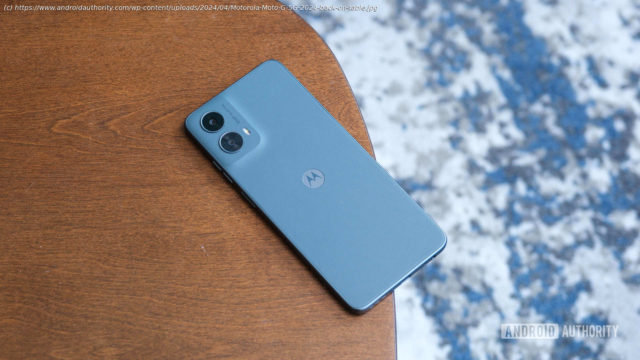Can Motorola find some magic in the middle of its Moto G lineup? It’s tricky, but find out in our Motorola Moto G 5G (2024) review.
Affiliate links on Android Authority may earn us a commission. Learn more.
Published on22 minutes agoMotorola Moto G 5G (2024)Motorola Moto G 5G (2024)
Motorola Moto G 5G (2024) review: At a glance
What is it? The Motorola Moto G 5G (2024) is the middle member of the 2024 Moto G lineup, replacing the 2023 model of the same name. It comes equipped with a Snapdragon 4 Gen 1 chipset, a pair of rear cameras, and a Sage Green vegan leather finish that feels as good as it looks. The Moto G 5G (2024) also packs NFC support (finally!), a headphone jack, and slightly improved wired charging.
What is the price? The Motorola Moto G 5G (2024) costs $199 in the United States and CA$249 in Canada.
Where can you buy it? The Motorola Moto G 5G (2024) launched in the US and Canada on May 2, 2024. It’s available directly from Motorola, through retailers like Amazon and Best Buy, and through mobile carriers in both countries.
How did we test it? I tested the Motorola Moto G 5G (2024) for seven days. Motorola supplied the review unit.
Is it worth it? Although the Motorola Moto G 5G (2024) outperforms its more affordable siblings, it can’t clear the increasingly high bar for budget Android phones. It still suffers from a weak update commitment, inflexible cameras, and limited charging options. Sure, it’s one of the most affordable options, but spending a little more money will vastly improve your Android experience. Should you buy the Motorola Moto G 5G (2024)?
Motorola’s Moto G series feels like the story of Goldilocks and the Three Bears. Forgive the pained metaphor ahead of time, but it’s true. The Moto G Play (2024) is Baby Bear, offering just the basics but doing so at a low price. The Moto G Power 5G (2024) is Papa Bear, offering the fastest charging, the best cameras, and the most power at a higher price. As you might have guessed, that leaves the Moto G 5G (2024) to fill the role of Mama Bear, landing somewhere between the Power and the Play with features like 5G and NFC (after years of not having the latter for baffling reasons) but slower charging and less flexible cameras. So, let’s find out if this affordable Android phone is just right.
Starting with the design, the Moto G 5G (2024) looks and feels closest to its premium Motorola Edge inspiration. It combines the fingerprint-resistant vegan leather back of the Moto G Power 5G with a camera bump that melds smoothly into the rest of the back panel, much like the Moto G Play. However, the Moto G 5G (2024) swaps the black, blue, and pink finishes of its siblings for a Sage color that’s easily the best of the bunch. It’s similar to the shade used on the more affordable Motorola Razr from 2023, appearing green in some lighting and almost gray in others.
Of course, the rest of the Moto G 5G (2024) is made of plastic — like most budget Motorola devices are — but the soft texture feels much better in hand than the slick plastic of the Moto G Play. Sure, vegan leather is technically just dressed up plastic, but it makes a big difference over a hard, slippery back when you’re holding your phone for hours on end. Motorola’s plastic frame is surrounded by the usual slate of buttons and ports, planting the fingerprint reader and volume buttons on the right with a headphone jack next to the USB-C port on the bottom edge, meaning you could probably find your way around in the dark if you’ve ever used another Moto G device.
Motorola’s dedication to the headphone jack is a love story for the ages, and I’m glad it’s still around. It’s better than relying on the Moto G 5G’s stereo speakers (a down-firing unit and the earpiece), which have a one-two punch of problems. They’re painfully quiet at anything less than full volume, yet badly distorted once you max them out — there’s no comfortable middle ground.
The Moto G 5G’s 6.6-inch LCD panel is another compromise between the Moto G Play and Moto G Power. It shares a lower HD+ resolution with the former (1,612 x 720) but adds the latter’s 120Hz refresh rate. On paper, the combination should be a good one, bringing a little extra power to the $200 price point, but the panel suffers from one of the Moto G Power’s most significant flaws: The viewing angles are atrocious. I’m not sure if Motorola tried to add a privacy screen protector, but the result is that you can barely see what’s on the Moto G 5G’s display unless you’re looking right at it. This is perfectly fine if you’re trying to keep notifications to yourself, but reading a recipe off the Moto G 5G (2024) is almost impossible while cooking. The low resolution of the Moto G 5G further hamstrings it, with everything from YouTube videos to watching We Own This City on Max coming out just a bit too fuzzy.
Unfortunately, Motorola also cut a few other corners to keep the Moto G 5G’s price low. The phone only comes with a Gorilla Glass 3 display, which is the bare minimum for durability. You also won’t find an official IP rating, though that’s less of a given at this price. Motorola says its Moto G lineup is water-repellent but can’t withstand jets of water or submersion, so be careful in anything heavier than light rain.
Adding to the cost-saving compromises, let’s dig into the Moto G 5G’s software. If you’re familiar with the Moto G series, you probably know what’s coming, and it’s not great. Although the Moto G 5G (2024) ships with Android 14 right out of the box, Motorola is only promising a single Android update, so it’ll eventually get Android 15, which is slated to launch later this year — but that’s it. Our unit also came with the February 1, 2024, security patch out of the box and is in line for just two years of security support. Yes, it’s a budget phone, but keep in mind the identically priced Samsung Galaxy A15 5G is covered for four years of software updates.
Thankfully, there are still a few things to like about Motorola’s My UX experience. It still looks and feels largely like stock Android, with several colorful personalization options and an app drawer almost identical to what you’d find on a Google Pixel device.
However, Motorola has sold out several other parts of its software experience to keep its price low. Simply put, ads are everywhere — even when you don’t realize they’re ads.






